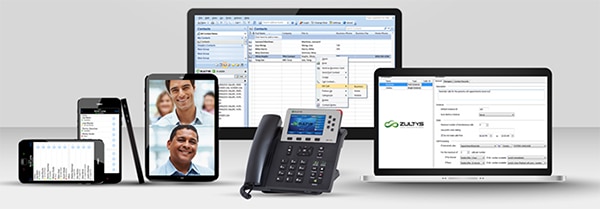Picture this: After taking the red-eye to your company’s New York office, you realize you can’t find your phone. It could have been stolen, or it could have been left in the airport restroom — the important thing is there’s a chat message on that phone with your reservation number, and you need it to get into the hotel. You wander around the lower deck of the airport until you finally find an outlet for your laptop, VPN into your company email, message the office manager and then wait for a response.
The example above is extreme, but it could have been avoided with a unified messaging system. Unified messaging, or UMS, connects important communication services, like your office voicemail, your email inbox, instant messages, faxes and a number of other channels all together in one place. It’s a convenient way to get the info you need fast, and it has several other benefits for large and mid-size organizations, particularly if you’re looking to upgrade your existing phone systems. In the sections below, we’ll examine five key advantages companies experience when they moved from legacy communication networks to UMS services.
Convenient Communication
Clearly, one of the main benefits of UMS is convenience. You can access your communications through both a phone and an email client — whatever is most appropriate at the time. That means discreetly checking your voicemail during a conference, without having to reach for your Bluetooth. Instead, instant messaging allows you to easily communicate important messages to the intended parties — and all of your messaging is stored in one central location. For employees who are frequently traveling or rushing from one meeting to the next, this kind of adaptability is a lifesaver.
Additionally, customization options allow voicemail users to forward messages to another inbox, create personal greetings for specific callers or temporarily pause alerts using “do not disturb” features. You can even integrate your calendars and video conferencing for an all-in-one solution that delivers seamless convenience.
Increased Productivity
Modern communication is designed to make life easier — but not when your work life is spread between six different platforms. At Taylored, we’ve seen firsthand how a variety of ad hoc communication applications and products can eat away at a company’s productivity. Employees spend unnecessary time duplicating their efforts across apps: summarizing a meeting to an employee who couldn’t be in on the call, responding to a voicemail through email, emailing the highlights of a back-and-forth chat to another department. The effect of all that extra work is reduced productivity and, in turn, a lower return on your investment for your software and infrastructure purchases.
Unified communication systems typically don’t introduce new functionality to your existing processes. Instead, they merge standalone apps and services into a single system. What makes UMS so convenient is also what makes it more efficient: Your staff can switch between email, instant messages and voicemail without opening and closing several applications.
Higher Cost Savings
As we hinted at before, the ROI for UMS just can’t be beat by conventional ad hoc systems. However, integrating unified communications typically reduces infrastructure costs as well. Businesses that combine their communication services generally require less physical server space to store internal and external messages. And that means not only lower hardware costs, but fewer resources going toward maintenance and support.
Support is another way many companies lose out when they decide to stick with legacy phone and email systems. A report compiled by Microsoft and COMMfusion showed that many companies were losing thousands — if not millions — of dollars each year due to support contracts initiated on older systems. Although many businesses apply the “if it isn’t broke, don’t fix it” philosophy to such legacy equipment, the gateway support costs alone average between $1,000 and $1,500 per year. Additionally, aging hardware has associated costs as well, as ports and devices must be frequently repaired or swapped out for newer equipment. Meanwhile, many modern UMS systems move functions like faxing to VoIP, which has saved businesses hundreds of thousands of dollars a year.
Improved Employee Safety
Unified communication systems can also be used to broadcast critical alerts to employees during emergency events. Employees who have the alert system can receive instant messaging, email or voicemail notifications on everything from weather closures to security threats, thus allowing you to immediately reach a wider swath of your employee population.
This kind of model has been successfully used on college campuses to warn students about potential danger, such as an active shooter in the area. Unfortunately, such incidents are on the rise, and it’s your job as an employer to do your due diligence to protect your employees. UMS adds one powerful tool to your prevention arsenal.
More Efficient Systems
UMS systems aren’t just more efficient on the user side of the equation. They’re also better from an IT perspective. Aging hardware is associated with more frequent downtime and outages, which represents a productivity loss for the IT staff that must solve the issue as well as the employees who rely on those services for critical work functions.
Additionally, many manufacturers have started dismantling support systems for outdated phone systems and email servers. As more of these products are discontinued, it will be increasingly difficult to manage outages and downtime, meaning more lost time for your business.
To be successful in tomorrow’s economy, your enterprise will need to be flexible and adaptive — and for the most part, that can’t happen with legacy systems that keep you tethered to the business models of a previous era. Unified messaging systems are an important destination on your company’s technology road map, and Taylored can provide a UMS solution to get you where you’re going.

